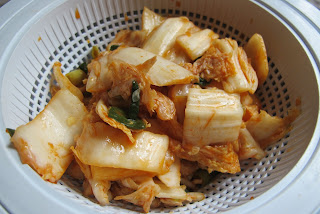I love food and yet there are still a lot of foods that I'm coming into late into life. Some I've posted about before. Things like squash and figs were items that I didn't grow up with and so I had no experiences to draw from. Some things were just plain stubborness. Like sushi. I only learned to eat it about seven years ago because I had the typical naive aversion to the idea of eating raw fish. Another is jalapeno peppers. I was afraid of them, I guess, until I cut one up in a burrito and realized that it added so much more flavor and heat. That was about 15 years ago. Or even being as silly as to not putting a flavoring into my hot chocolate. Now I can't stand hot chocolate plain, I have to have some sort of additional flavor added to it.
Kimchi was one of those scary foods. After all, it's fermented cabbage with a reputation for being spicy. Don't get me wrong. I love spicy foods. Yet, here I was having a stubborn obstinance to trying this strange looking concoction of hot cabbage.
That's all gone now. I've sampled several versions of kim chi at Korean restaurants that serve relish trays as an appetizer. My favorite application of kimchi - in Drewski's Mustang, a grilled cheese with Korean short rib, kim chi, and a sarachi aioli. Awesome!
After seeing another blog post on how easy it is to make, I've finally made my first batch. Stay tuned later this week for a recipe in which I use the finished product.
Taken from DavidLebovitz.com
Kimchi
About 3 cups (750ml)
1 large Napa cabbage (2 pounds, 1kg)
2 tablespoons coarse salt (do not use fine table salt)
1/3 cup (80ml) white rice vinegar
3 tablespoons Korean chili pepper paste (gochujang)
1 tablespoon very-finely minced garlic
2 tablespoons coarse Korean chili powder (gokchu garu)
1/2 tablespoon very-finely minced fresh ginger
4 scallions, sliced in 2-inch (5cm) batons, including the green part
1. Remove the tough outer leaves of the cabbage and slice it lengthwise in half. Remove the core.
2. Cut the cabbage into 2-inch (5cm) pieces. Toss the cabbage with the salt in a large bowl, then transfer it to a non-reactive colander. Set a plate on top then weigh it down with something heavy for 24 hours.
3. Mix together the vinegar, chili paste, garlic, chili powder, and ginger in a large, non-reactive bowl. The original recipe says to let this stand overnight as well, but I didn’t.
4. Add the cabbage in handfuls to the marinade, taking small bunches at the time and squeezing them of any excess water before adding them to the marinade. Mix the cabbage with the marinade, adding the scallions as well.
5. Pack into a jar, cover tightly, and let stand at room temperature 48 hours, then chill for 4 days before serving.

.png)




